L7 | CHATS
thought leadership
The Ontology Advantage: Enabling Smarter, Connected Decisions in Life Sciences with L7|ESP®
by Vasu Rangadass, Ph.D. | posted on October 08, 2025
How an ontology-driven platform is transforming fragmented data into a self-learning digital twin for Research, Development, and Manufacturing.
TL;DR:
L7|ESP provides life sciences their breakthrough moment, an ontology-driven platform that turns disconnected research, development, and manufacturing data into a living digital twin of the organization. The result is a continuously learning enterprise where every decision builds intelligence, speed, and compliance.
Over the past decade, industries ranging from finance to defense have adopted advanced data platforms to integrate complex systems, inform better decisions, and foster self-learning organizations. Some of the most prominent examples include Palantir, which built its reputation on unifying fragmented data streams into actionable intelligence; Google, whose Knowledge Graph connects billions of facts into a semantic network that powers intelligent search; and Amazon, which employs ontology-based data architectures to contextualize relationships among customers, products, and logistics. While Palantir may spark debate, its name has come to represent the power of unifying complex data for actionable insights—a helpful lens for understanding L7|ESP’s capabilities in life sciences.
Just as these platforms transformed their industries, life sciences now face a similar crossroads: an explosion of scientific, operational, and regulatory data (projected to grow at an annual rate of over 36%¹) has created both opportunities and challenges. The need for a platform that unifies this data, contextualizes it, and continuously improves decision-making has never been greater.
This is where L7 Informatics and its flagship platform, L7|ESP®, come in. Already trusted by some of the world’s largest pharmaceutical companies, leading cancer centers, and technology partners, L7|ESP combines an ontology-based architecture with a living, evolving digital twin of the organization. It doesn’t just manage data, it contextualizes it, turning fragmented information into actionable intelligence. For life sciences, this represents the same kind of paradigm shift that Palantir, Google, and Amazon brought to other sectors, but purpose-built for the scientific enterprise and regulatory compliance.
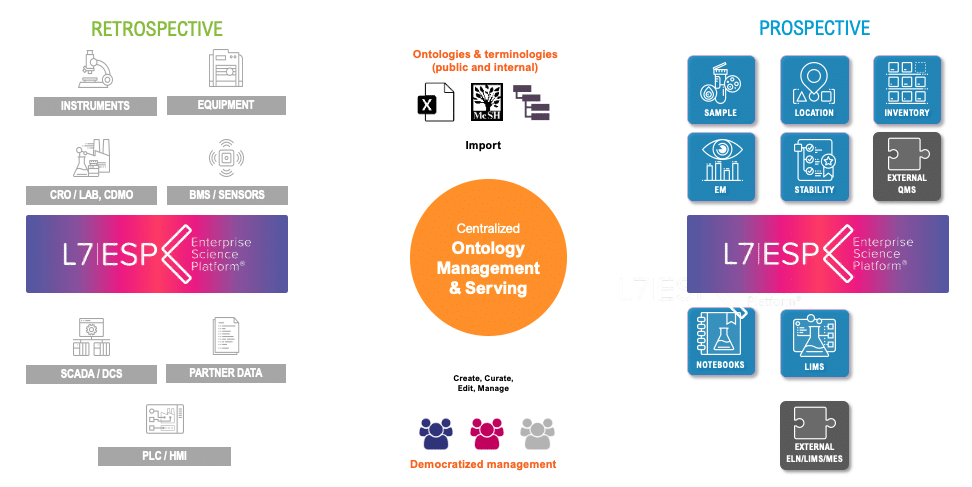
Why Ontologies are Key: a State of Unified Data Harmony
Ontology-Based Data Model as the Digital Backbone
An ontology is more than a data model; it’s a framework that integrates an organization’s data, assets, and actions into a coherent digital representation, supporting informed decision-making. Think of it as the scientific method applied to enterprise operations: capture the context of an experiment (master data, inputs, instruments, protocols), record the decision made (the action taken), measure the outcome, and feed the learnings back into the system. This creates a feedback loop where every new experiment or operational decision strengthens the collective intelligence of the organization.
In biology, ontologies such as the Gene Ontology have long been used to standardize knowledge across various disciplines. In the life sciences industry, examples include work to create a pharmaceutical Chemistry Manufacturing and Controls (CMC) Ontology as a foundation to enable full digitization of pharmaceutical CMC data, which enables scheduling and prioritization of work and interoperability.
L7|ESP takes this trusted concept and applies it at the organizational level. The result: a platform that doesn’t just define and manage data but contextualizes it—making it actionable (decision-ready), connected, and traceable.
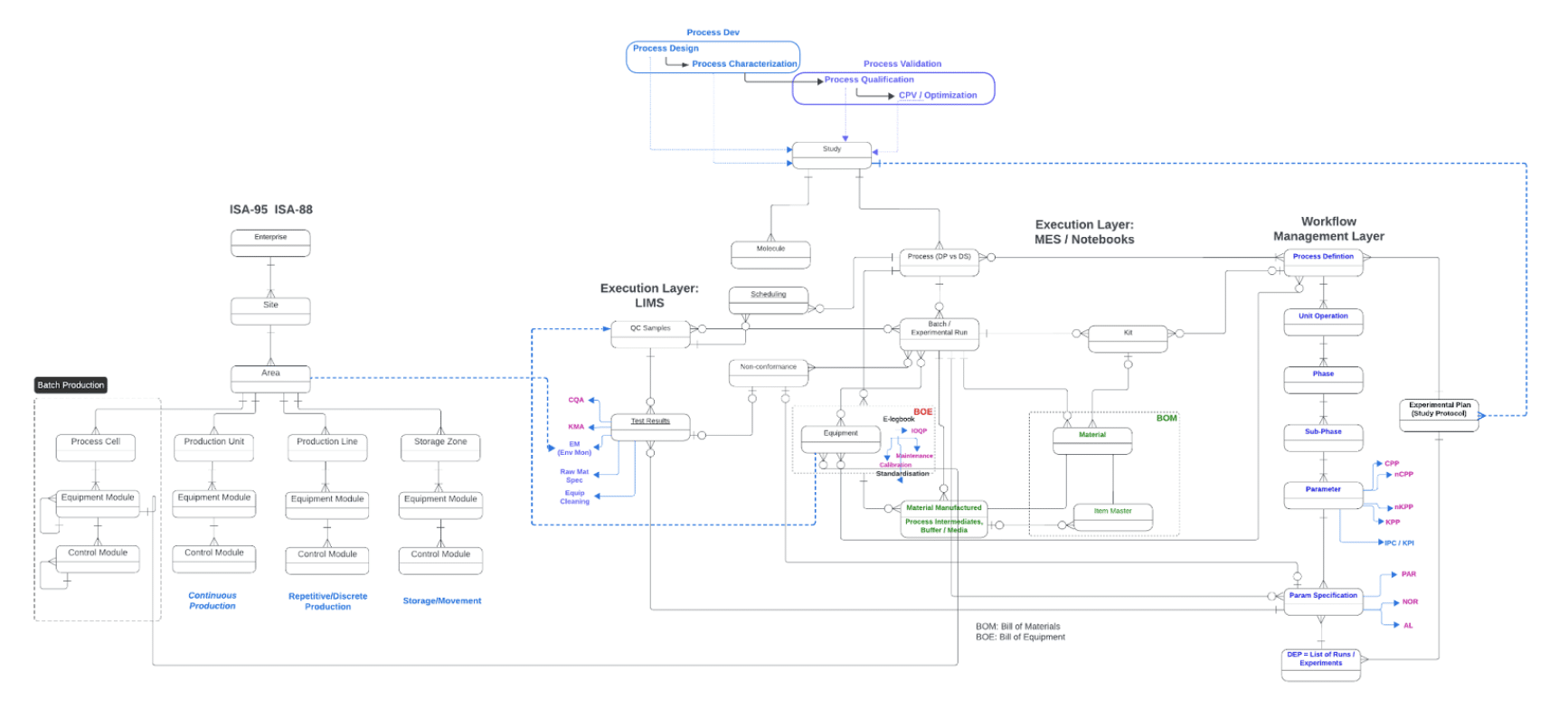
FDA Process Validation Guideline
Why Palantir’S ARCHITECTURE Became a Model, and Why Life Sciences Need Their Own
Palantir succeeded by giving organizations in finance, government, and defense the ability to see across silos and act on insights with speed and confidence. Their focus wasn’t just in data integration; it was in building a knowledge graph that evolved as the organization worked and learned.
Life sciences now face the same systemic challenges. Data silos between labs, instruments, clinical systems, and manufacturing lines create blind spots. Decisions are often made without considering the full context of prior learning from experiments, the better design of experiments, or operational constraints (such as resource availability). The risk is wasted effort, missed insights, missed due dates, and compliance headaches. In fact, data silos hinder cross-functional collaboration in nearly half of pharmaceutical companies, with more than half of those with annual revenues over $1 billion reporting significant impacts on efficiency.
Where Palantir built a platform for security and decision intelligence, L7|ESP is doing the same for life sciences and healthcare. It provides the connective tissue—data and workflow—needed to unify research, discovery, development, and manufacturing, while embedding scientific rigor at every step. And yes, with the same knowledge graph capabilities that evolve as the organization progresses.
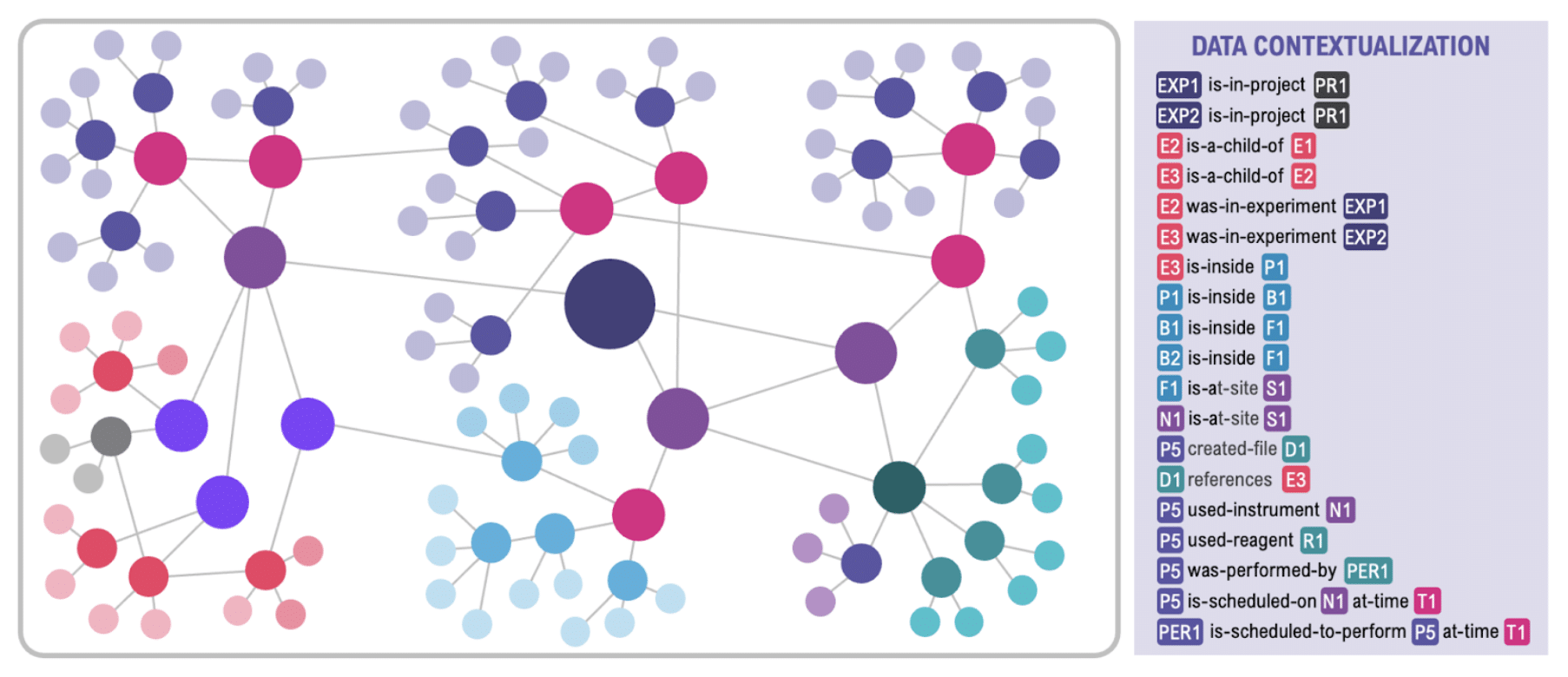
L7|ESP Creates Knowledge Graphs Automatically via Orchestration of Business Processes
L7|ESP: The Digital Twin of Your Scientific Organization
At the core of L7|ESP is the ability to create a digital twin of your scientific and operational enterprise. This isn’t just a dashboard or a workflow engine; it’s a living model that mirrors the real-world state of your products, people, and processes.
Data Integration: Fragmented sources, including omics data, electronic lab notebooks, and manufacturing execution systems, are harmonized within a shared ontology.
Process Contextualization: Every experimental design, workflow step, and operational decision is captured with context, ensuring reproducibility and traceability.
Feedback Loops: Outcomes are automatically linked back to decisions, creating a cycle of learning that continuously sharpens predictions and insights.
The result is a platform that gets smarter over time—just like a seasoned scientist whose knowledge grows with every experiment.
Why Ontologies and L7|ESP Matters Now
Life sciences are in a phase of exponential complexity. Next-generation sequencing, cell and gene therapies, personalized medicine, and AI-driven drug discovery are pushing the boundaries of what data can do. Yet the infrastructure for integrating and contextualizing this data lags far behind.
Without ontology, organizations risk creating brittle systems; with ontologies, integrations become scalable and standardized, workflows connected and adaptable, and data lakes semantically enriched. With ontology, every piece of data, every action, and every outcome becomes part of a larger, structured narrative. This is the difference between drowning in data and driving discovery.
The comparison to Palantir isn’t casual. Like Palantir, L7|ESP provides a foundation for data-driven decision-making across complex organizations. However, unlike Palantir, L7 is explicitly tailored to the needs of the life sciences, where the stakes aren’t just financial or geopolitical—they’re human health and scientific progress.
Scientific Rigor: Ontology ensures that data is not just integrated but contextualized according to scientific standards.
Regulatory Readiness: Every decision and outcome is captured, supporting compliance and auditability.
Future-Proofing: As new modalities and workflows emerge, the ontology-based framework adapts, ensuring long-term scalability and flexibility.
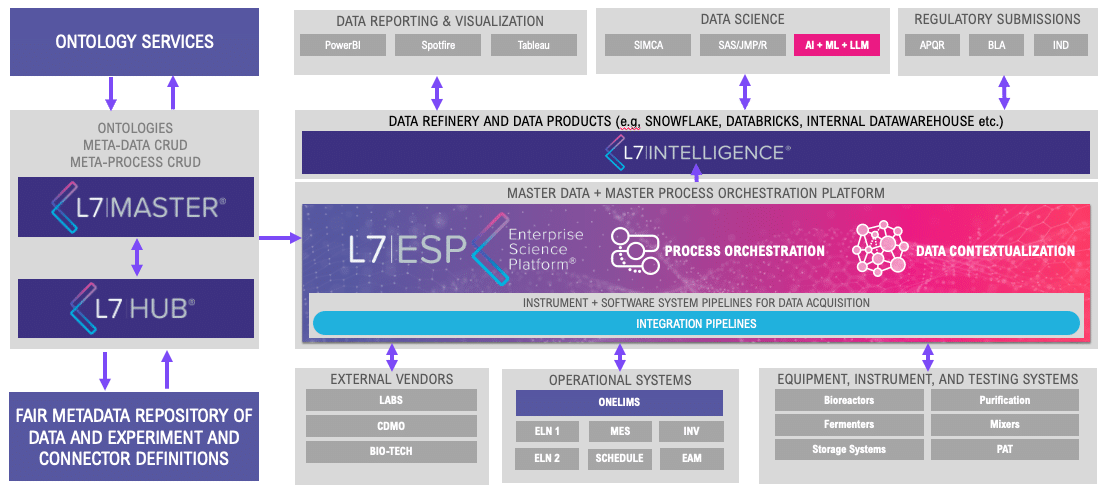
L7|ESP is the Reference Architecture for Life Sciences
A New Era of Decision Intelligence in Life Sciences
The future of the life sciences depends on organizations’ ability not just to generate data, but to turn that data into informed decisions—and to learn from those decisions continuously. Palantir, Google, and Amazon have already shown that ontology-based platforms can transform entire industries. L7|ESP has brought that same level of decision intelligence to life sciences.
For organizations seeking to transition from data chaos to a future of integrated, self-improving intelligence, ontology is no longer optional. It is the digital backbone of discovery, development, and delivery. And L7 Informatics is leading the way.
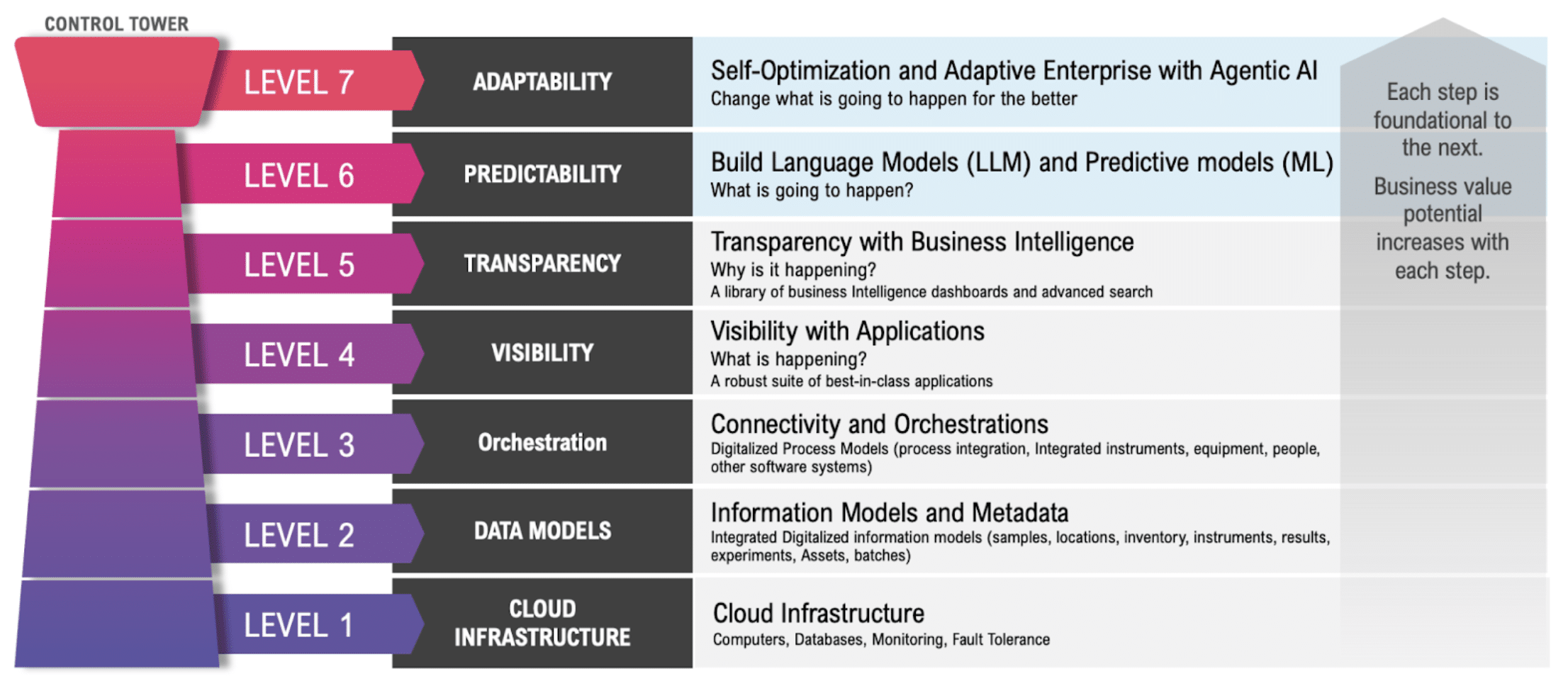
L7|ESP is the Digital Unified Platform for Life Sciences, built on Industry 4.0 Principles.
For additional insights into digital twins, decision intelligence, and regulatory readiness, see our FAQ on ontology platforms for life sciences.
____
Footnote:
¹ RBC Capital Markets. The Healthcare Data Explosion. 2023.
Sources:
European Pharmaceutical Manufacturer. Data Silos Threaten Efficiency Levels for Nearly Half of Pharma Businesses. February 13, 2023.
Deloitte 2025 Life Sciences Executive Outlook. December 10, 2024.
IDC. Are Data Silos Hindering Your Supply Chain Visibility?
J Pharm Innov 17, 155–169 (2022). An Ontology to Describe Small Molecule Pharmaceutical Product Development and Methodology for Optimal Activity Scheduling. 2020.
Pistoia Alliance. CMC Ontology. 2025.
